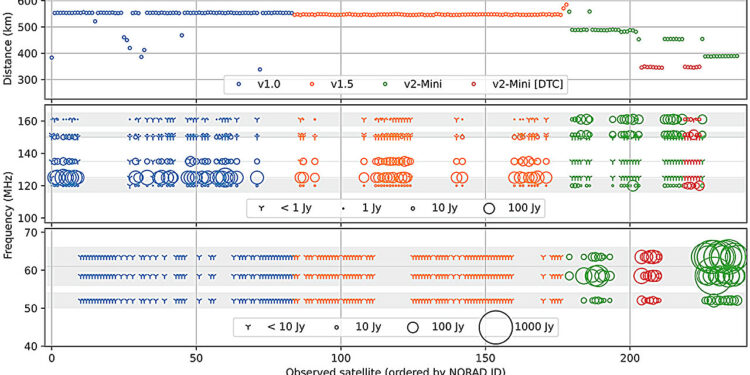Measurements of the distances and power flux density of the Starlink satellites that passed through the beam of the two one-hour LOFAR observations. Credit: Astronomy and astrophysics (2024). DOI: 10.1051/0004-6361/202451856
Observations made last year with the Low Frequency Array (LOFAR) radio telescope showed that first-generation Starlink satellites emit unintentional radio waves that can interfere with astronomical observations.
New observations with the LOFAR radio telescope, the largest radio telescope on Earth observing at low frequencies, have shown that the second-generation Starlink V2-mini satellites emit unintentional radio waves up to 32 times brighter than previous-generation satellites, which can potentially blind radio telescopes and cripple vital research into the universe.
The study is published in the journal Astronomy and astrophysics.
In recent years, the number of satellites launched into low Earth orbit (LEO) has exploded, largely due to the rapid commercialization of space and advances in satellite technology. Since 2019, companies like SpaceX and OneWeb have launched hundreds, if not thousands, of satellites, particularly for communications purposes.
Forecasts show that the number of satellites launched into orbit could exceed 100,000 by the end of the decade. The increase in radio wave emissions from low-orbit satellites raises serious concerns about the future of astronomical research.
This study was conducted using the LOFAR radio telescope, which involved two long one-hour observing sessions on July 19, 2024, covering radio frequencies above and below the FM broadcast band used by the radio stations you receive with your home radio.
During these observations, the team detected unintentional electromagnetic radiation (UEMR) from nearly every Starlink satellite observed, including first- and second-generation satellites.
“With LOFAR, we have launched a program to monitor unintentional emissions from satellites belonging to different constellations, and our observations show that the second-generation Starlink satellites emit stronger emissions and do so over a wider range of radio frequencies, compared to the first-generation satellites,” says Cees Bassa of ASTRON (Netherlands Institute for Radio Astronomy), lead author of the study.
The analysis found that these new satellites emit unintentional radio waves up to 32 times brighter than the first generation, with levels potentially exceeding internationally regulated thresholds for interference set for intentional emissions and even more relaxed terrestrial electromagnetic compatibility standards.
“Compared to the faintest astrophysical sources we observe with LOFAR, the UEMR of Starlink satellites is 10 million times brighter. This difference is similar to that of the faintest stars visible to the naked eye and the brightness of the full moon. Given that SpaceX is launching about 40 second-generation Starlink satellites every week, this problem is getting worse and worse,” adds Cees Bassa.
This study highlights the need for stricter regulation of unintentional satellite radiation to preserve the sanctity of radio astronomy observations, which are essential to understanding the universe and our place in it. This study is a clear call to action to safeguard the future of astronomy in the face of advances in satellite technology.
“Humanity is clearly approaching an inflection point where we must act to preserve our sky as a window to explore the universe from Earth. Satellite manufacturers are not interested in producing this unintentional radiation, so minimizing it should also be a priority in their sustainable space policies,” says Federico Di Vruno of the SKA observatory. “Starlink is not the only big player in low Earth orbit, but it has a chance to become the reference in this field.”
The researchers point out that while second-generation satellites were designed to improve connectivity and provide communication services, unintentional radio emissions pose a growing threat to the integrity of astronomical observations. As the consequences of such interference become increasingly evident, collaboration between satellite companies, regulators and the astronomical community is essential to design effective mitigation strategies.
In the Netherlands, one of the most densely populated countries in Europe, ASTRON operates LOFAR, the world’s most sensitive low-frequency telescope. This is only possible thanks to the regulatory support of Dutch local, provincial and national agencies. Municipalities consult ASTRON before any development and support the institute by advising others.
Professor Jessica Dempsey, ASTRON’s Chief Scientific Officer, said: “Since LOFAR began more than a decade ago, when we were told we would soon have difficulty observing due to radio interference, regulatory support and productive industry collaboration, totalling more than 1,000 individual mitigation actions, have been achieved in collaboration with dozens of groups, companies, infrastructures, agencies and individuals across the country.”
“And this relationship is not a one-way street. These clever techniques for detecting faint signals in the universe have enabled industry and society to make technological advances, from GPS to Wi-Fi. We don’t just coexist, we thrive together. We have the solutions for this symbiosis in space, too. We just need the support of regulators and the help of industry. Without mitigation measures, very soon, the only constellations we will see will be man-made.”
More information:
CG Bassa et al, Intense and unintentional electromagnetic radiation from second-generation Starlink satellites, Astronomy and astrophysics (2024). DOI: 10.1051/0004-6361/202451856
Powered by Astronomy & Astrophysics
Quote:Second-generation Starlink satellites leak 30 times more radio interference, threatening astronomical observations (2024, September 18) retrieved September 18, 2024, from
This document is subject to copyright. Apart from any fair dealing for the purpose of private study or research, no part may be reproduced without written permission. The content is provided for informational purposes only.



